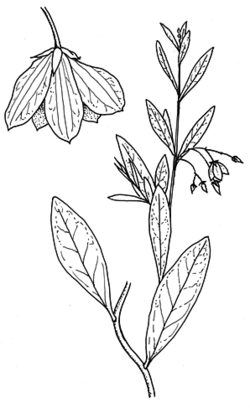Common name: Purple Appleberry, Bluebell Creeper
Billardiera heterophylla (Lindl.) L.W.Cayzer & Crisp APNI* Synonyms: Sollya heterophylla Lindl. APNI*

Description: Slender twiner or flexuous prostrate to rounded shrub; new shoots silky hairy; older stems angular with cuticular ridging; reddish brown.
Juvenile leaves tripartite to trilobed; petiole as long as lamina. Adult leaves linear, 10–20(-30) mm long, 2–15 mm wide, softly hairy, eventually becoming glabrescent with age; margin undulate, slightly thickened; apex acute with small mucronate; petiole 1–2 mm long.
Inflorescence terminal, cymose, with 1–3 flowers; pedicels 6–7 mm long, slender, nodding. Sepals narrowly triangular to acicular, 2–3 mm long, densely hairy. Petals slightly obovate, 6–8 mm long, blue to mauve. Stamens with filaments shorter than anthers; anthers yellowish. Ovary obloid, pink-mauve, ridged, with dense silky hairs (particularly on ridges); style short, thick initially, elongating beyond anthers after anthesis; stigma small capitate.
Fruits spindle-shaped, less than 10 mm long, dark green or purple; seeds red-brown.
Flowering: Flowers in January
Distribution and occurrence: Naturalised in Central and Southern Tablelands (NSW); Vic. SA & Tas. Native to WA. Garden escape (in eastern Australia and parts of Western Australia), growing in sclerophyll forest and shrublands
NSW subdivisions: *SC, *CT
Other Australian states: *S.A. *Tas. W.A.
The salt tolerance and potential use of this species in reclamation of saline areas requires careful investigation because of its ability to escape from cultivation.
Text by B.J. Conn
Taxon concept: L.W. Cayzer, M.D. Crisp & I.R.N. Telford (2004)
APNI* Provides a link to the Australian Plant Name Index (hosted by the Australian National Botanic Gardens) for comprehensive bibliographic data
***The AVH map option provides a detailed interactive Australia wide distribution map drawn from collections held by all major Australian herbaria participating in the Australian Virtual Herbarium project.
|


